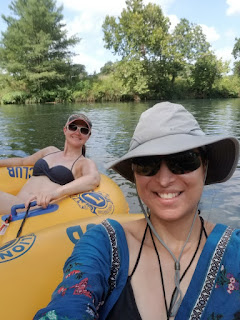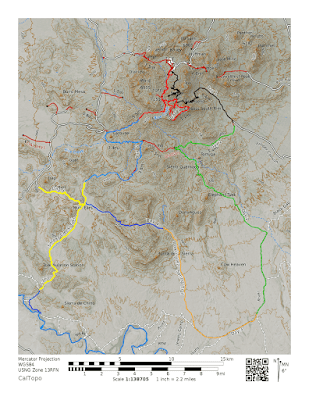Training to Hit the Trail
How to Train for Hiking
There are many
reasons why people want to hike and backpack: enjoying nature, staying healthy,
aspiring photographer, or fun family event.
Whatever your reason for getting outside, you need to be fit enough to accomplish
your objective. If not, hiking will
quickly turn into a military style ruck march where you are miserable, head
down, and only worrying about one foot in front of the other. That is not how the outdoors was meant to be
explored.
What Type of Exercise is Hiking?
Hiking and
backpacking are primarily aerobic activities (think running and walking), but
there are aspects of anaerobic activities as well (think sprinting or weight
lifting). Hiking is an aerobic activity
because it is pretty much just walking with a pack on over uneven terrain. The reason hiking is anaerobic is usually the
need for leg power. You need that leg
power to jump across a stream or step up a large rock.
Taking it one-step
further, hiking uses almost all of your muscles to a varying degree, but your
lower body will have to work the hardest.
Your lower body (quads, hamstrings, glutes, etc.) are the muscles that
are going to keep you moving, provide bursts of power, support the weight of
your pack, keep you stable, and absorb some impact. The next set of muscles helping you out is
your core (abs and back muscles). This
group of muscles is essential to keeping you up right, stopping you from
tumbling over, and helping to support your pack. The final group and least used is your upper body
(arms, chest, upper back, and shoulders).
Your shoulders and upper back will be used the most out of this group by
supporting some of the weight of your pack; however, upper body strength is
important for things like lifting your pack and other skills required to hike
and backpack.
Training
To start with, I
will cover the best method for getting in hiking and backpacking shape, which
is sport specific training. Sport
specific training is performing the activity to get better at the activity. This would be putting on a weighted pack and
walking over uneven terrain aka going on hikes.
This can be difficult to do with a busy life, living in the city, or if
you are just starting to train. However,
I do recommend doing a short hike with a light pack during the weekend as part
of your training plan.
Aerobic
For the rest of us
who only have a limited amount of time, if any time extra time, is to walk or
run daily. Walking and running are
similar to hiking and will increase your base aerobic fitness level, which will
carry over to hiking. If you already running,
then keep on running and add short hikes on the weekends. In addition, runners
should slowly transition runs to trail running.
This will focus on support and stabilizer muscles as you run over uneven
terrain, which will be similar to hiking.
If you are just starting out, start by walking and increasing your
mileage slowly. When you feel healthy
enough and capable, start adding a run to your workout routine and increasing the
amount of runs gradually. Plus, you want
to do short, easy hikes on your weekends as well.
 |
| Trail running is one of the best exercises besides hiking to get you hiking ready. Courtesy of Wikimedia |
Anaerobic
While working on
your cardio is probably the most important, adding some core exercises and resistance
training couldn’t hurt. For the lower
body, try weighted lunges and weighted squats.
These two exercises will increase the power of almost every muscle in
your lower body. For the core, try
planks, side planks, crunches, and scissor kicks. Finally, for upper body do tried and true push-ups
and pull-ups. These exercises should be
a nice start and mix to get you started and require only limited amount of
equipment.
 |
| Squats are one of my favorite lower body exercises and I use them in all my training routines. Courtesy of Wikimedia |
Flexibility
Flexibility is a
huge issue for hikers and backpackers and as most of us try to create a stable
platform while hiking with little movement.
This is because moving too far out of the normal range of motion with a
pack on can cause injuries. In addition,
stiff muscles after a long day’s hike are less fun than loose muscles. Moreover, flexible muscles are better able to
handle jerks and weird movements without becoming injured.
To increase flexibility
it is important to get a good warm up and stretch before you start hiking. Also, you need a nice cool down and stretch
at the end of the day when you are done hiking.
It also wouldn’t be a bad idea to add a few stretches in on your hiking
breaks. My final recommendation would
be yoga; do yoga once a week at your house or sign up for a class. Either way it will be a huge benefit to your
flexibility and overall comfort level out on the trails.
Final Thoughts
While I am no expert
and you should always check with your doctor before starting new physical activities,
this article should get you started in the right direction as far as
training. The key is, it’s not exactly
what you do it’s that you are active and having fun. If you are active and enjoying yourself, it
will all eventually come together to create great hiking trips.
What are
you doing to train for your upcoming hiking or backpacking trips? Also, if you like the blog, please follow us
on Facebook.




Comments
Post a Comment